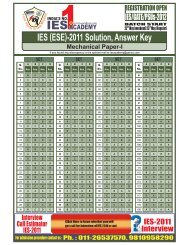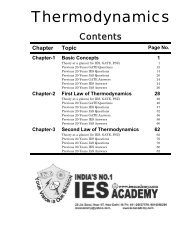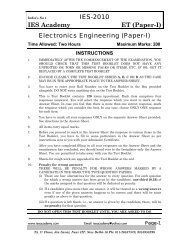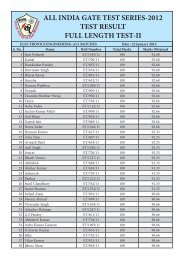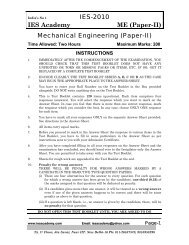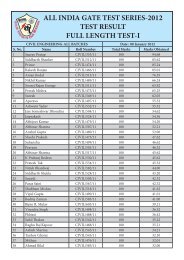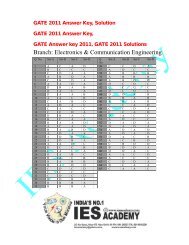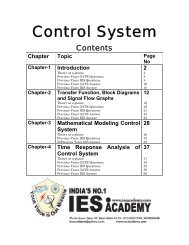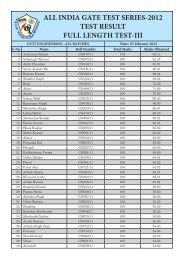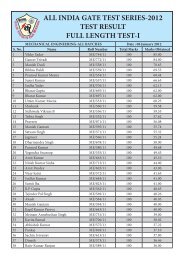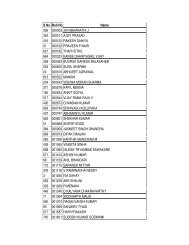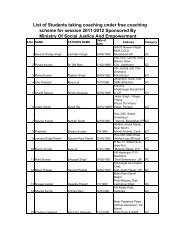Electrical Machine - IES Academy
Electrical Machine - IES Academy
Electrical Machine - IES Academy
You also want an ePaper? Increase the reach of your titles
YUMPU automatically turns print PDFs into web optimized ePapers that Google loves.
India’s No. 1<br />
<strong>IES</strong> <strong>Academy</strong><br />
Transformer<br />
Chapter-1<br />
Iron loss does not depend upon the load but upon the applied voltage.<br />
<strong>IES</strong>-4. Ans. (a)<br />
p1<br />
75 3<br />
<strong>IES</strong>-5. Ans. (a) η= where, η= =<br />
p2<br />
100 4<br />
∴ p1<br />
9<br />
p<br />
=<br />
2<br />
16<br />
<strong>IES</strong>-6. Ans. (d) Air-core means non-iron core so there will be no hysteresis losses.<br />
<strong>IES</strong>-7. Ans. (d)<br />
<strong>IES</strong>-8. Ans. (d) Magnetizing flux φα V f<br />
but core loss depends upon the frequency.<br />
<strong>IES</strong>-9. Ans. (a) Load for η<br />
max<br />
= full load<br />
Iron loss<br />
copper loss<br />
<strong>IES</strong>-10. Ans. (b) Hysterisis loss not depend on thickness of lamination and time.<br />
2 2 2<br />
<strong>IES</strong>-11. Ans. (d) Eddy current loss P<br />
e<br />
=kB<br />
e maxf t<br />
V<br />
2 2<br />
Bmax<br />
α . So, P<br />
e<br />
= k<br />
e<br />
V f<br />
f<br />
where, t = thickness; f = frequency; and B<br />
max<br />
= flux density<br />
So, P<br />
e<br />
will be same or no change in eddy current loss.<br />
<strong>IES</strong>-12. Ans. (b) Load for η<br />
max<br />
=<br />
iron loss 1<br />
full load = 100<br />
copper loss 2<br />
= 70.7 kVA<br />
ES-13. Ans. (d) Iron losses not change due to load variations copper losses ∝ (loading in Pu) 2 .<br />
2 2 2<br />
<strong>IES</strong>-14. Ans. (d) P<br />
e<br />
= K<br />
e<br />
B f t where t is thickness.<br />
<strong>IES</strong>-15. Ans. (c) A part of the winding being common, leakage flux and therefore leakage<br />
reactance is less.<br />
V<br />
<strong>IES</strong>-16. Ans. (b) Answer would depend upon the voltage ratio a = 1 and type of autotransformer<br />
i.e., step-up or step-down.<br />
V2<br />
For step-up transformer<br />
⎛ 1 ⎞<br />
( KVA ) = ( KVA)<br />
Auto ⎜ ⎟<br />
[where a < 1]<br />
two-wdg<br />
⎝1-a<br />
⎠<br />
For step-down transformer<br />
⎛ a ⎞<br />
( KVA ) = ( KVA)<br />
Auto ⎜ ⎟<br />
[where a > 1]<br />
two-wdg<br />
⎝a-1⎠<br />
1<br />
Let, N1 = N2 (Ideal two winding transformer) for step-up transformer a= 2<br />
then ( KVA ) = 2 × ( KVA )<br />
auto<br />
two-wdg<br />
For step-down transformer = 2, then ( KVA ) = 2 × ( KVA )<br />
<strong>IES</strong>-17. Ans. (c) Let V<br />
1<br />
(primary) > V 2<br />
(secondary)<br />
auto<br />
two-wdg<br />
www.iesacademy.com E-mail: iesacademy@yahoo.com Page-51<br />
25, 1 st Floor, Jia Sarai, Near IIT. New Delhi-16 Ph: 011-26537570, 9810958290



